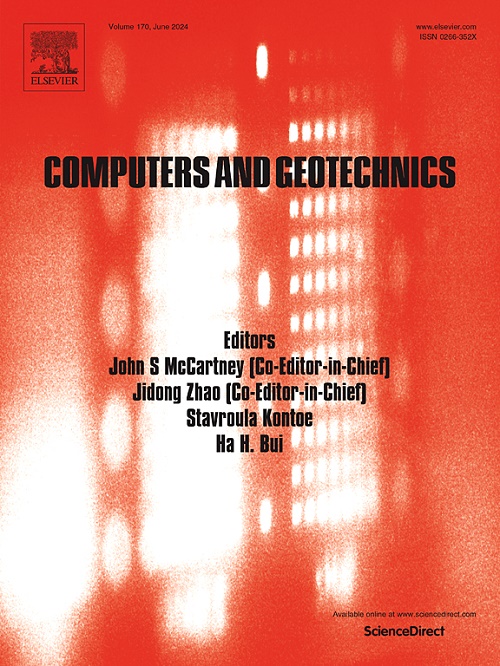Molecular insights into the adsorption behavior of PFAS on montmorillonite, polyethylene, and polypropylene: A molecular dynamics study
IF 5.3
1区 工程技术
Q1 COMPUTER SCIENCE, INTERDISCIPLINARY APPLICATIONS
引用次数: 0
Abstract
Per- and polyfluoroalkyl substances (PFAS) are persistent environmental contaminants that pose significant challenges for subsurface containment and remediation. In this study, molecular dynamics simulations were employed to investigate the adsorption behavior of three representative PFAS compounds, including fluorotelomer alcohol (FTOH), perfluorooctane sulfonate (PFOS), and perfluorooctanoic acid (PFOA), on montmorillonite, polyethylene (PE), and polypropylene (PP), which are commonly encountered in geotechnical and barrier system materials. Simulation results indicate that FTOH exhibits the highest adsorption density on the polymeric matrices (PP and PE), whereas PFOS and PFOA preferentially adsorb onto montmorillonite. The strong adsorption of PFOS and PFOA on montmorillonite is primarily governed by electrostatic interactions between their oxygenated and sulfonate functional groups and the negatively charged clay surfaces. In contrast, adsorption on PE and PP is dominated by van der Waals interactions with the PFAS fluorocarbon tails. The overall adsorption affinity follows the trend: montmorillonite > PP > PE, consistent with calculated interaction energies and mean squared displacement analyses. Additionally, the molecular structure of PFAS, specifically chain length and functional group composition, was found to significantly influence adsorption dynamics. These insights enhance the mechanistic understanding of PFAS retention and mobility in geomaterials, providing a foundation for improved modeling and risk assessment of contaminant transport in geotechnical systems.
PFAS在蒙脱土、聚乙烯和聚丙烯上的吸附行为:分子动力学研究
全氟烷基和多氟烷基物质(PFAS)是持久性环境污染物,对地下控制和修复构成重大挑战。在这项研究中,采用分子动力学模拟研究了三种代表性的PFAS化合物,包括氟端聚物醇(FTOH),全氟辛烷磺酸(PFOS)和全氟辛酸(PFOA),在蒙脱土,聚乙烯(PE)和聚丙烯(PP)上的吸附行为,这三种化合物常见于岩土和屏障系统材料中。模拟结果表明,FTOH在聚合物基体(PP和PE)上的吸附密度最高,而PFOS和PFOA优先吸附在蒙脱土上。全氟辛烷磺酸和全氟辛烷磺酸在蒙脱土上的强吸附主要是由它们的氧和磺酸官能团与带负电荷的粘土表面之间的静电相互作用决定的。相比之下,在PE和PP上的吸附主要是与PFAS氟碳尾的范德华作用。总体吸附亲合力遵循以下趋势:蒙脱土;页的在PE,与计算的相互作用能和均方位移分析一致。此外,PFAS的分子结构,特别是链长和官能团组成,对吸附动力学有显著影响。这些见解增强了对PFAS在岩土材料中保留和迁移的机理理解,为改进岩土系统中污染物迁移的建模和风险评估提供了基础。
本文章由计算机程序翻译,如有差异,请以英文原文为准。
求助全文
约1分钟内获得全文
求助全文
来源期刊

Computers and Geotechnics
地学-地球科学综合
CiteScore
9.10
自引率
15.10%
发文量
438
审稿时长
45 days
期刊介绍:
The use of computers is firmly established in geotechnical engineering and continues to grow rapidly in both engineering practice and academe. The development of advanced numerical techniques and constitutive modeling, in conjunction with rapid developments in computer hardware, enables problems to be tackled that were unthinkable even a few years ago. Computers and Geotechnics provides an up-to-date reference for engineers and researchers engaged in computer aided analysis and research in geotechnical engineering. The journal is intended for an expeditious dissemination of advanced computer applications across a broad range of geotechnical topics. Contributions on advances in numerical algorithms, computer implementation of new constitutive models and probabilistic methods are especially encouraged.
 求助内容:
求助内容: 应助结果提醒方式:
应助结果提醒方式:


